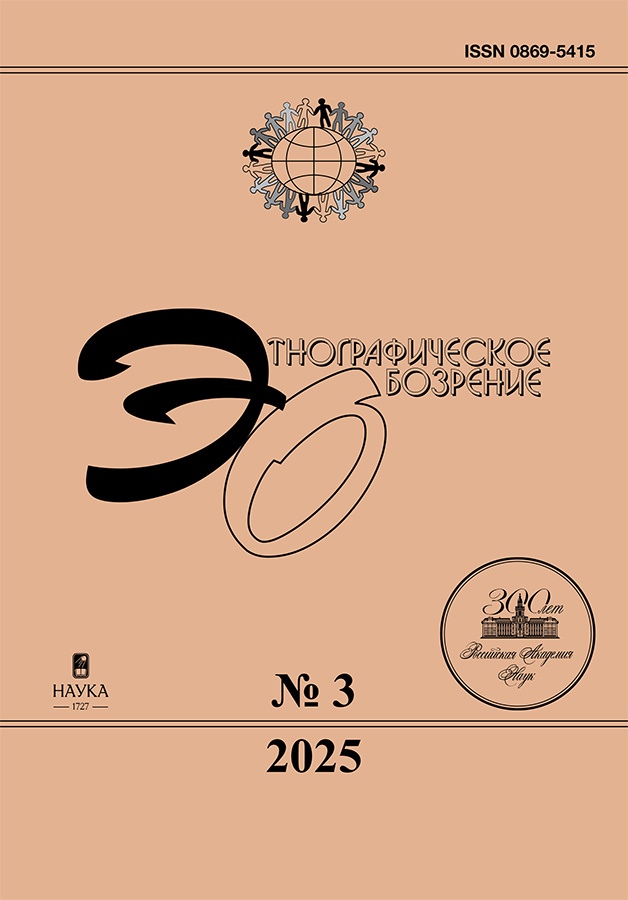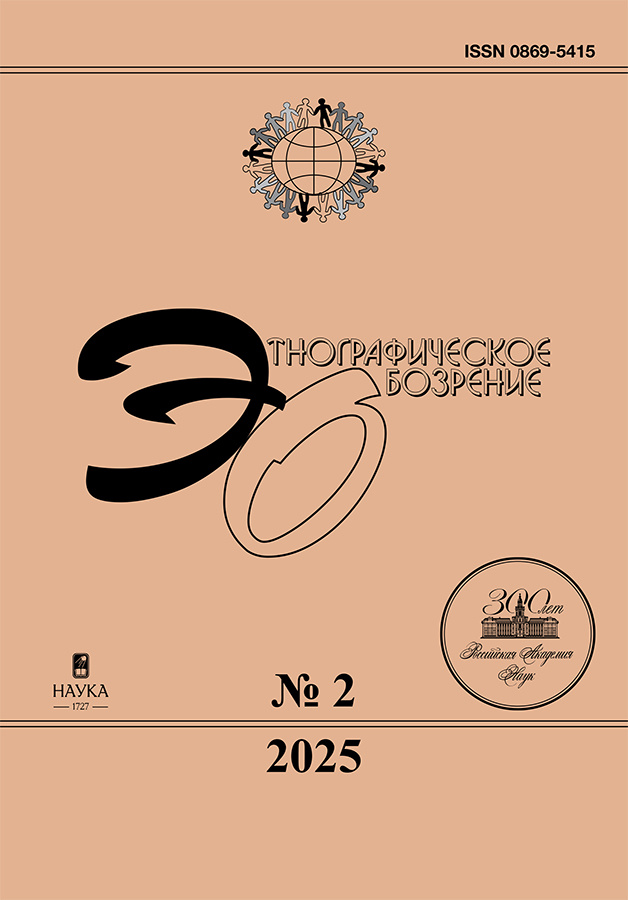Nganaasan Idols and Soviet Ethnographers Through the Lens of Critical Heritage Studies: From Sacred to Museum Objects
- Authors: Mochalova M.1
-
Affiliations:
- Institute of Ethnology and Anthropology, Russian Academy of Sciences
- Issue: No 2 (2025)
- Pages: 35–55
- Section: Special Theme of the Issue: Anthropology of Heritage: Critical Concepts in Russian Contexts (guest editor P.S. Kupriyanov)
- URL: https://rjonco.com/0869-5415/article/view/686643
- DOI: https://doi.org/10.31857/S0869541525020036
- EDN: https://elibrary.ru/TKWTQO
- ID: 686643
Cite item
Abstract
This study examines the interactions between Soviet researchers and sacred Nganaasan objects known as koika-idols in the 20th century. The systematic ethnographic study of the Nganaasan people, the accumulation of knowledge about them, and the museumification of their culture began alongside Soviet modernization on the Taimyr Peninsula. The modernization process included efforts to combat indigenous peoples' traditional beliefs, which simultaneously were subjects of interest for Soviet ethnographers. In the case studies researchers appear as observers of their informants' practices of interaction with various idols, sometimes becoming involved in these practices themselves, describing both the objects and rituals, witnessing and participating in the collision between traditional beliefs and modernizing discourse, and, notably, bringing the idols themselves to museums, thus becoming actors in the process of indigenous heritage production. Drawing on L. Smith's critical concept of authorized heritage discourse (AHD), the author attempts to describe the origins of indigenous heritage space formation in the USSR, trace decision-making processes, and analyze the knowledge production practices about the Nganaasans by some of their first researchers – A.A. Popov and B.O. Dolgikh. Various levels of problems related to the role of scholars in heritage production and indigeneity discourses are examined. The research is based on published and archival texts of Soviet researchers, materials from the author's field research on the Taimyr Peninsula in 2021, 2022, 2024, as well as data collected from museum and scientific archives.
Full Text
About the authors
Maria Mochalova
Institute of Ethnology and Anthropology, Russian Academy of Sciences
Author for correspondence.
Email: Masha.mochalova@iea.ras.ru
ORCID iD: 0000-0003-2702-737X
младший научный сотрудник
Russian Federation, 32a Leninsky prospekt, Moscow, 119991References
- Appadurai, A. 2017. Museum Objects as Accidental Refugees. Historische Anthropologie 25 (3): 401–408.
- Baranov, D. 2021. The “Turn” and Other Turns: Museum Anthropology and Material Culture Studies in Russia. Anthropologica 63 (2): 1–26. https://doi.org/10.18357/anthropologica63220211037
- Churilova, L.A. 1991. Rol’ muzeev v sokhranenii i razvitii kul’tury narodnostei Severa (1917–1980 gg.): na materialakh narodnostei Severa Srednei Sibiri [The Role of Museums in the Preservation and Development of the Culture of the Peoples of the North (1917–1980): On Materials of the Peoples of the North of Central Siberia]. PhD diss. Abstract, IEA RAN.
- De la Cadena, M., and O. Starn, eds. 2007. Indigenous Experience Today. London: Routledge.
- Diachenko, V.I., and L.R. Pavlinskaia. 2023. А.А. Popov – etnograf, tiurkolog, religioved i fol’klorist [A.A. Popov – Ethnographer, Turkologist, Religious Scholar and Folklorist]. In Religioznye predstavleniia dolgan [Religious Beliefs of the Dolgans], by A.A. Popov, 28–30. St. Petersburg: MAE RAN.
- Dobrova-Yadrintseva, L.N. 1925. Tuzemtsy Turukhanskogo kraia: opyt issledovaniia ekonomicheskogo polozheniia [Natives of the Turukhansk Region: A Study of the Economic Situation]. Novonikolaevsk: Sibirskii Revoliutsionnyi Komitet.
- Dolghikh, B.O. 1938. Legendy i skazki nganasanov [Legends and Tales of the Nganasans]. Krasnoiarsk: Krasnoiarskoe knizhnoe gosudarstvennoe izdatel’stvo.
- Dolghikh, B.O. 1964. Problemy etnografii i antropologii Arktiki [Problems of Arctic Ethnography and Anthropology]. Sovetskaia etnografiia 4: 76–90.
- Gonzalez, P.A. 2018. The Heritage Machine: Fetishism and Domination in Maragateria, Spain. London: Pluto Press.
- Gracheva, G.N. 1977. Traditsionnye kul’ty nganasan [Traditional Nganasan Cults]. In Pamiatniki kul’tury narodov Sibiri i Severa (vtoraia polovina XIX – nachalo XX v.) [Cultural Monuments of the Peoples of Siberia and the North (Second Half of the 19 – Beginning of the 20 Century)], edited by I.S. Vdovin, 217–228. Leningrad: Nauka.
- Gracheva, G.N. 1980. Taimyrskie kollektsii MAE (dolgany i nganasany) [Taimyr Collections of the MAE (Dolgans and Nganasans)]. In Sobraniia Muzeia antropologii i etnografii AN SSSR [Collections of the Museum of Anthropology and Ethnography, USSR Academy of Sciences], edited by D.A. Olderogge, 57–64. Leningrad: Nauka.
- Gracheva, G.N. 1981. Shamany u nganasan [Shamans among the Nganasan]. In Problemy istorii obshchestvennogo soznaniia aborigenov Sibiri [Problems of the History of Social Consciousness of Siberian Aborigines], edited by I.S. Vdovin, 69–89. Leningrad: Nauka.
- Gracheva, G.N. 1981. Kul’tovyi komplekt nganasan [Nganasan Cultic Set]. In Material’naia kul’tura i mifologiia [Material Culture and Mythology], edited by B.N. Putilov, 153–168. Leningrad: Nauka.
- Gracheva, G.N. 1983. Traditsionnoe mirovozzrenie okhotnikov Taimyra [Traditional Worldview of Taimyr Hunters]. Leningrad: Nauka.
- Gracheva, G.N. 1984. Posleslovie [Afterword]. In Nganasany: sotsial’noe ustroistvo i verovaniia [Nganasans: Social Construction and Beliefs], by A.A. Popov, 144–145. Leningrad: Nauka.
- Harrison, R. 2013. Heritage: Critical Approaches. London: Routledge.
- Helimsky, E.A., ed. 1994. Taimyrskii etnolingvisticheskii sbornik: materialy po nganasanskomu shamanstvu i yazyku [Taimyr Ethnolinguistic Collection: Materials on Nganasan Shamanism and Language]. Moscow: RGGU.
- Hirsch, F. 2022. Imperiia natsii. Etnograficheskoe znanie i formirovanie Sovetskogo Soiuza [Empire of Nations: Ethnographic Knowledge and the Formation of the Soviet Union]. Moscow: NLO.
- Ivanov, S.V. 1970. Skul’ptura narodov Severa Sibiri XIX – pervoi poloviny XX veka [Sculpture of the Northern Peoples of Siberia in the 19th – First Half of the 20th Century]. Leningrad: Nauka.
- Liarskaia, E.V. 2010. O babushkakh, modeli sviashchennogo mesta i muzeinoi etnografii [On Grandmothers, Models of Sacred Space and Museum Ethnography]. In Nomen est omen. Sbornik statei k 60-letiiu N.B. Vakhtina (ot neposlushnykh uchenikov) [Nomen est omen: Collection of Articles for the 60th Anniversary of N.B. Vakhtin (From Naughty Pupils)], edited by A.K. Baiburin and E.V. Golovko, 161–177. St. Petersburg: Izdatel’stvo Evropeiskogo universiteta v Sankt-Peterburge.
- Middendorff, A.F. 1878. Puteshestvie na sever i vostok Sibiri [Journey to the North and East of Siberia]. Vol. 2 (6). St. Petersburg.
- Momzikova, M.P. 2024. Post-Fieldwork Letters: Soviet Scholars, Nganasan Correspondents, and the Co-Production of Anthropological Knowledge through Reciprocal Dialogue. Novoe literaturnoe obozrenie 190: 44–62. https://doi.org/10.53953/08696365_2024_190_6_44
- Mochalova, M.A. 2022. Shaman v muzee: opyt izucheniia naslediia korennogo soobshchestva resursnogo regiona [Shaman in the Museum: The Experience of Studying the Heritage of an Indigenous Community in a Resource-Type Region]. Sibirskie istoricheskie issledovaniia 4: 195–220. https://doi.org/10.17223/2312461X/38/11
- Mochalova, M.A. 2024. The Production of Knowledge and Heritage as a Struggle Against Uncertainty: The Case of the Indigenous Peoples of Taimyr in the 1920s–1930s. Sibirskie istoricheskie issledovaniia 1: 139–165. https://doi.org/10.17223/2312461X/43/10
- Moore, E.L. 2022. Indigenous Heritage. In The Cambridge Handbook of Material Culture Studies, edited by L.A. De Cunzo and C.D. Roeber, 236–266. Cambridge: Cambridge University Press.
- Petriashin, S.S. 2024. Sovetskaia muzeinaia etnografiia na VII Mezhdunarodnom kongresse antropologicheskikh i etnograficheskikh nauk: restavratsiia i konservatsiia distsiplinarnogo naslediia pod “vzgliadom” Zapada [Soviet Museum Ethnography at the VII International Congress of Anthropological and Ethnographic Sciences: Restoration and Conservation of Disciplinary Heritage under the “Gaze” of the West]. Etnograficheskoe obozrenie 2: 68–88. https://doi.org/10.31857/S0869541524020048
- Popov, A.A. 1936. Tavgiitsy: materialy po etnografii avamskikh i vadeevskikh tavgiitsev [Tavgi People: Materials on the Ethnography of the Avamsk and Vadeevsk Tavgi]. Moscow: AN SSSR.
- Popov, A.A. 1948. Nganasany [Nganasans]. Vol. 1, Material’naia kul’tura nganasan [Material Culture of Nganasans]. Moscow; Leningrad: Nauka.
- Popov, A.A. 1959. Die “Kuojka” Familien und Sippenschutzgeister bei den Nganasanen [The ‘Koujka’ Families and Clan Guardian Spirits among the Nganasanen]. In Opuscula Ethnologica Memoriae Ludovici Biro Sacra [Ethnological Pamphlets of the Memory of Ludovicus Biro Sacra], 23–37. Budapest: Akademiai Kiado.
- Popov, A.A. 1963. The “Kuoika” Guardian Spirits of Family and Clan among the Nganasan. Arctic Anthropology 1 (2): 122–130.
- Popov, A.A. 1984. Nganasany: sotsial’noe ustroistvo i verovaniia [Nganasans: Social Structure and Beliefs]. Leningrad: Nauka.
- Savoskul, S.S. 2009. Etnograf Krasnoiarskogo muzeia – B.O. Dokgih v 1937–1944 [Krasnoiarsk Museum Ethnographer B.O. Dolgikh in 1937–1944]. Etnograficheskoe obozrenie 1: 100–118.
- Simchenko, Y.B. 1974. Terminologiia rodstva u nentsev, entsev, nganasan i yukagirov [Kinship Terminology of the Nenets, Ents, Nganasans, and Yukagirs]. In Sotsial’naia organizatsiia i kul’tura narodov Severa [Social Organization and Culture of the Peoples of the North], edited by I.S. Gurvich, 270–291. Moskow: Nauka.
- Simchenko, Y.B. 1976. Kul’tura okhotnikov na olenei Severnoi Evrazii: etnograficheskaia rekonstruktsiia [The Culture of Reindeer Hunters of Northern Eurasia: An Ethnographic Reconstruction]. Moscow: Nauka.
- Simchenko, Y.B. 1996. Traditsionnye verovaniia nganasan [Nganasan Traditional Beliefs]. Pt. 1. Moscow: Nauka.
- Smith, L. 2006. Uses of Heritage. London: Routledge.
- Tretiakov, P.I. 1971. Turukhanskii krai, ego priroda i zhiteli [Turukhansky Krai, Its Nature and Life]. St. Petersburg: tipografiia V. Bezobrazova i K°.
- Vallikivi, L. 2019. What Does Matter? Idols and Icons in the Nenets Tundra. In Estonian Study of Religion: A Reader, edited by I. Peedu and M. Arukask, 302−330. Tartu: University of Tartu Press.
Supplementary files











